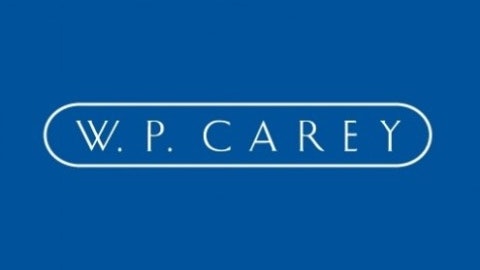Also worth noting, from a valuation standpoint, the following chart shows WPC’s FFO per share has been rising, but not quite as fast as the share price has been rising, which is an indication of an increasingly rich valuation.

Risks:
W.P. Carey Inc. REIT (NYSE:WPC) is not without risks. Not only does it face many of the usual REIT risks (such as the risk of regulatory changes, the potential foregoing of attractive investment opportunities in order to maintain its REIT status, and the simple fact that many investors consider REITs unattractive right now because the category continues to selloff after rallying so hard earlier this year). In addition to these risks, we believe there are three often overlooked but significant risks that are worth considering (i.e. W.P. Carey’s upcoming wall of low interest rate debt maturities, the persistent drag and risks of its foreign currency hedging program, and some significant conflicts of interest in its managed REITs program).
Interest rate risks, and the wall of maturities
We saw in our earlier regression model that WPC’s price tends to be negatively impacted when interest rates rise, but this reaction may soon be magnified by the upcoming wall of WPC debt maturities as shown in the following table.

Specifically, 20% of WPC debt matures in 2019, and this also happens to be the portion of the debt with the lowest interest rate. This means (depending on interest rates at that time) that WPC may have to raise additional capital at a much higher interest rate in 2019 which could have a significantly negative impact on profitability. For example, if WPC has to re-borrow another $845 million at 3.5% (instead of 1.5%) this is potentially an additional $16.9 million of annual debt payments. And considering Net Income was only $51.7 million in the most recent quarter, this increased debt payment is not insignificant. And realistically, if interest rates begin to rise then a higher debt payment burden becomes a risk for all debt maturing in the coming years, not just the 2019 debt.
Non-US exposures and currency hedging costs
WPC’s non-US investment exposures and currency hedging costs are another significant risk factor worth considering. For starters, a third of WPC’s properties are in Europe, and this introduces an entirely different set of risk exposures ranging from regulations to the fact that Europe is at a different point in the economic cycle than the US. And while this is arguably good from a diversification standpoint, it’s also expensive because WPC attempts to hedge its foreign currency exposures. Before getting into some of the details of the hedges, it’s worth acknowledging that the investment banks underwriting these very large forward hedging contracts are getting a large cut in the form of a bid-ask spread on a very regular and repetitive basis (and this cost is a very real and consistent drag on WPC’s profits).





